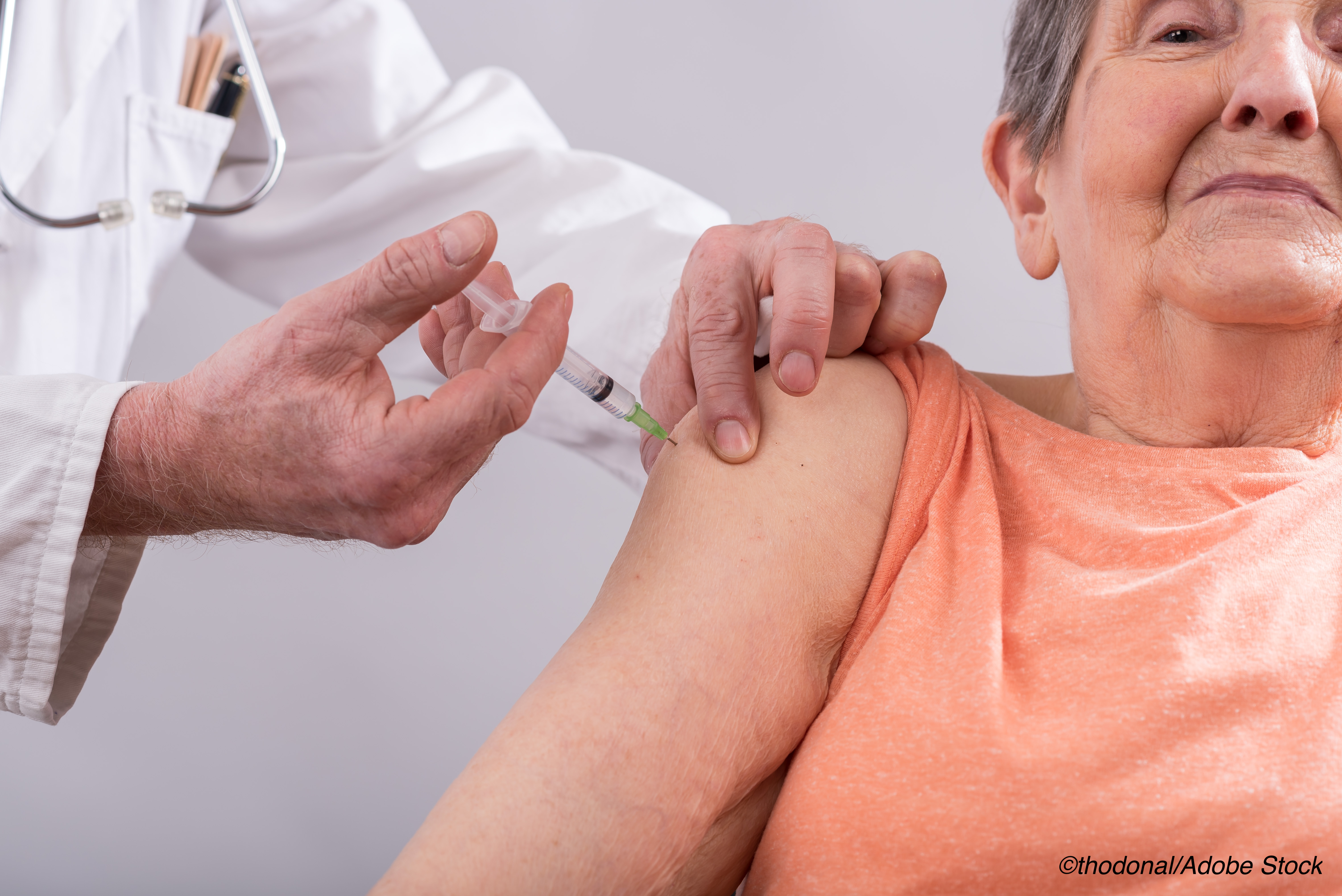Elderly residents of long-term care facilities receiving a single dose of either ChAdOx1 nCoV-19 (Oxford-AstraZeneca) or BNT162b2 (Pfizer-BioNTech) mRNA-based vaccines were protected against SARS-CoV-2 for 4-7 weeks, suggesting that the vaccines confer substantial protection against developing Covid-19 and could prevent its spread in a congregate setting. That said, the researchers who investigated the protective effect of the two vaccines noted that infection risk is not eliminated, and non-pharmacologic mitigation efforts should still be undertaken.
“We estimated vaccine effectiveness to be 56% (95% CI 19-76) at 28–34 days and 62% (23–81) at 35-48 days,” Laura Shallcross, PhD, UCL Institute of Health Informatics, UCL, London, and colleagues wrote in The Lancet Infectious Diseases. “Beyond this time, there was insufficient evidence for a protective effect when looking at both vaccines combined; however, data for BNT162b2, for which there was more person time at risk available than for ChAdOx1, indicate that a protective effect was maintained beyond 7 weeks. We have only evaluated the effect of the first dose of each vaccine, but our findings constitute some of the earliest evidence on real-world effectiveness of the ChAdOx1 vaccine and of Covid-19 vaccines in long-term care facility residents.”
Another study, published in the same issue from Catherine Hyams, PhD, from Population Health Sciences, University of Bristol, Bristol, U.K., and colleagues, looked at the efficacy of the two vaccines in hospitalized patients age 80 or older and basically found the same thing—conferred benefit of the vaccines in this vulnerable population.
“These two studies give cause for optimism; despite older individuals developing decreased humoral responses to vaccines, including SARS-CoV-2, vaccine efficacy is high, and second doses will probably increase efficacy further,” Maria Prendecki, MBBS, PhD, and Michelle Willicombe, MD, MBBS, from the Centre for Inflammatory Disease, Department of Immunology and Inflammation, Imperial College, London wrote in an accompanying commentary. “We await data on clinical vaccine efficacy in other vulnerable groups, including those at risk of vaccine hyporesponsiveness, such as those with organ transplants or receiving immunosuppression.”
In their prospective cohort study, dubbed VIVALDI, Shallcross and colleagues recruited participants starting on June 11, 2020, “to investigate SARS-CoV-2 transmission, infection outcomes, and immunity in residents and staff in long-term care facilities in England that provide residential or nursing care for adults aged 65 years and older.” Those included in the study were asymptomatic residents of long-term care facilities who were routinely tested for SARS-CoV-2 from Dec. 8, 2020, to March 15, 2021.
Along with the routine testing, nonpharmacologic interventions—social distancing, isolation of any symptomatic and confirmed cases, use of personal protective equipment, visitation restrictions, and outbreak control measures—were continued.
“Using Cox proportional hazards regression, we estimated the relative hazard of PCR-positive infection at 0–6 days, 7–13 days, 14–20 days, 21–27 days, 28–34 days, 35–48 days, and 49 days and beyond after vaccination, comparing unvaccinated and vaccinated person-time from the same cohort of residents, adjusting for age, sex, previous infection, local SARS-CoV-2 incidence, long-term care facility bed capacity, and clustering by long-term care facility,” Shallcross and colleagues wrote. “We also compared mean PCR cycle threshold (Ct) values for positive swabs obtained before and after vaccination.”
Their analysis included 10,412 residents ages 65 or older from 310 facilities. The media age of the participants was 86, more than half were female, and 11.1% (1155 residents) had evidence of prior SARS-C0V-2 infection.
The majority of the residents (9,160 [88.0%]) received at least one vaccine dose; 6,138 (67.0%) received ChAdOx1 and 3,022 (33.0%) received BNT162b2.
“Between Dec. 8, 2020, and March 15, 2021, there were 36,352 PCR results in 670,628 person-days, and 1335 PCR-positive infections (713 in unvaccinated residents and 612 in vaccinated residents) were included,” Shallcross and colleagues wrote. “Adjusted hazard ratios (HRs) for PCR-positive infection relative to unvaccinated residents declined from 28 days after the first vaccine dose to 0.44 (95% CI 0.24-0.81) at 28–34 days and 0.38 (0.19-0.77) at 35–48 days.”
The effect sizes were similar for the two vaccines—ChAdOx1 (adjusted HR 0.32, 95% CI 0.15–0.66) and BNT162b2 (0.35, 0.17–0 71) at 35–48 days.
“Mean PCR Ct values were higher for infections that occurred at least 28 days after vaccination than for those occurring before vaccination (31.3 [SD 8.7] in 107 PCR-positive tests versus 26.6 [6.6] in 552 PCR-positive tests; P<0 0001),” the study authors wrote.
Notably, the study authors found that in facilities where there had been no evidence of previous infection, the results were similar to the main analysis (adjusted HR 0.36, 95% CI 0.18–0.73 at 35–48 days).
“When compared with unvaccinated residents with no previous SARS-CoV-2 infection, unvaccinated residents with previous infection had a significantly lower hazard of infection (adjusted HR 0.12, 95% CI 0.04–0 35),” Shallcross and colleagues explained. “Among long-term care facility residents with previous SARS-CoV-2 infection, we found no evidence to suggest that a single dose of vaccine further reduced the risk of PCR-positive infections beyond previous infection alone at any timepoint.”
Limitations of their study include the inability to quantify indirect effects of the vaccine rollout in England at long-term care facilities and the possible effects on herd immunity, and because vaccine data for staff inoculation were uncertain, they did not adjust for this in their study.
-
Elderly residents of long-term care facilities receiving a single dose of either ChAdOx1 nCoV-19 (Oxford-AstraZeneca) or BNT162b2 (Pfizer-BioNTech) vaccines were protected against SARS-CoV-2 for 4-7 weeks, suggesting that the vaccines confer substantial protection against developing Covid-19 and could prevent its spread in a congregate setting.
-
VIVALDI study researchers noted that infection risk is not eliminated and non-pharmacologic mitigation efforts should still be undertaken.
Candace Hoffmann, Managing Editor, BreakingMED™
This study was funded by the UK Government Department of Health and Social Care.
Shallcross reports grants from the UK Department of Health and Social Careduring the conduct of the study and is a member of the Social Care Working Group, which reports to the Scientific Advisory Group for Emergencies.
Pendrecki and Willicombe declared no relevant relationships.
Cat ID: 190
Topic ID: 79,190,282,494,931,728,791,932,730,933,190,926,255,927,151,928,925,934



